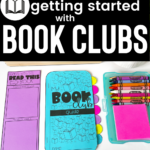One of my favorite activities with students has always been book clubs. Book clubs are one of the most effective ways to engage students in reading. I absolutely love watching the students discuss their books & take ownership of their learning. Participating in book clubs is so important because it not only fosters students' comprehension but also encourages students to use accountable talk & participate as a part of a group. And getting started with book clubs can be easy for you and your students! Just as you ease into any procedures in your classroom, as you ease into book clubs, students will form habits that will help them develop a lifelong love for reading…and talking about reading!

Planning for book clubs can feel intimidating, but creating routines that help keep the book clubs simple will allow them to serve their true purpose; which is allowing students time and space to discuss books in a student led setting. Book clubs are truly the best way to involve and interest students in reading. From the most reluctant reader to your eager bookworms, each student will learn and grow from the time they spend in your classroom participating in book clubs.
Here are a few tips for starting book clubs in your classroom.
Prepping for Book Clubs
There does not have to be a lot of prep involved when you are getting ready for book clubs. Choosing books, deciding on a schedule, and deciding how students will organize their materials are a few important things to consider.
1. Choosing a Book
As you get ready for your first book club, choosing a book that your students will love is always the fun part. To help your students feel comfortable with the reading, participation, and routines of book clubs, you can choose one book for the whole class to ensure that everyone is on the same page (literally and figuratively) and you can model as much as possible before you break into smaller, completely student-led groups.
Doing a whole group “soft start” to book clubs gives you the opportunity to truly go through each part of a book club, the expectations, and also is a great chance to model, model, model what a successful book club looks like.
Here are a few favorite books that your students may enjoy reading and discussing as a whole class to get your book clubs started:
2. Getting Organized
Staying organized is an important part of book clubs, You may choose to use folders or notebooks for your book clubs. Students can keep important pages together, such as: book club expectations, planning pages, reminders of their job descriptions, how to use accountable talk in groups, and their notes throughout the week.
To help students stay organized with all of their materials together, composition notebooks fit nicely inside gallon sized Ziploc bags. Students can keep their notebooks, books, a pencil, bookmark, and anything else they may find helpful to complete their book club in one bag! Ziploc bags really do last a long time, even through the wear & tear of desks, lockers & backpacks. And even if you have to replace a bag (or two…or three), the protection that it gives to your classroom books or borrowed books is worth it!
3. Preparing Routines
Once you have picked a book and you know how students will keep their materials, it's time to get into the routines. Some things to consider as you are getting ready to start your book clubs:
- When will your book clubs meet?
- Where will the groups meet?
- How long will the discussion be for each group?
- How will you facilitate the discussions?
A few tips:
- I recommend meeting once a week on the same day each week. Students become familiar with the schedule and there is no confusion on when they are meeting.
- About 10-15 minutes is usually an ideal time for a book club…some groups may want to keep talking, so be flexible and understand that the time may be different for different groups
- While students are reading assigned pages and completing “jobs” for their book club, the conversations should flow and feel natural. This allows students to truly talk about their books without feeling forced to do so. Sit back and allow them to simply talk, facilitate and jump in when needed.

Grouping Students for Book Clubs
There are a few options to choose from when you're getting students started in book clubs. While grouping students, you may:
- Group by their reading level & have students in each small group read the same book.
- Pick a topic or theme & have students read different books in their small groups that focus on the topic.
- You can group students according to their interests & let them choose their own book based on those interests.
- Choose an author & have each group read a different book by that author.
- You can also group students based on skills that you think each student could benefit from focusing on.

Groups should ideally be about 4-6 students and should change often throughout the year. Allowing students to meet with their classmates, all with varying levels of reading and different interests will help them grow as readers and thinkers.
Now Let's Get Started!
THIS TeacherTube video is a really great example of a successful book club. It shows students participating in a book club; their conversation really flows, they ask questions, make connections, and truly discuss the book in depth. Students can really connect when they watch others in action!
After watching the video, you can discuss or make an anchor chart of things you notice about the discussion students are having. This is a great way to show students how a book club is run and introduce the expectations of book club. You can also discuss book care, your reading contract, each job, when to stop & jot & how to stop & jot, how to plan out the reading, and the schedule.
You can then assign pages for students to read for your first meeting as a whole group.
The First Meeting
After going through all of the routines and procedures of book club, it is time to get started and read! When it comes to the first book club, you can have your students sit in a large circle where everyone can participate; sharing their notes, questions, and thoughts. They are usually timid in this first meeting & that is why sitting as a whole group is great at the beginning. The students that are not comfortable yet can easily observe and take it all in.

Meeting as a whole group really allows you to facilitate, model asking questions, being a good listener, and more.
The Second Meeting
When you are ready for the next book club, a fishbowl model is a great way for students to participate as well as observe. You can split students into two groups: remembering those that were very active last week & those that were timid can be helpful so that you can mix them up. Spread out students that you can predict will participate & some that you hope will open up more.
Group one can sit in a large circle on the outside observing as group 2 sits in a small circle, inside the bigger circle. Group 1 is observing Group 2’s discussion. You can sit in Group 2 & participate in the discussion to model what a good participant & listener does. When group 2's discussion is over, group 1 can give them positive feedback. They can point out everything they noticed about their discussion. Then they can switch! This gives everyone a chance to observe & to participate.
The Third Meeting
Discuss the accountable talk that you noticed in the Teacher Tube video & from classmates in week 2. Discuss any struggles students may be having; keeping up with reading, taking notes, participating in the book club. And as students are sharing their struggles, others can help by sharing how they've managed to keep up & prepare. Continue with the fishbowl model as you did in your second book club meeting, but create two new groups.

The Fourth Meeting
At this time, students have had a chance to participate & observe some great book club discussions. An ideal time to complete a book in your book clubs is about a month or so, meeting about 4 times. This gives students a chance to read the entire book and have some really great discussions about it. So by this time, you can break them up into small groups to try out a REAL book club for the last meeting of your whole group book.
Wrapping Up Book Clubs
After meeting four times to discuss their books, students usually work on a short, fun project to wrap up the book. This is something that they do on their own or with their group, depending on the project and the time frame needed. This “buffer” time where students are working on the project then gives you time to create new groups and choose books for the next book club.
After the whole group trial period, you can start small, student-led book clubs. And after the whole group modeling, students are usually very clear about their role in the book club. Book clubs will soon become a regular part of your reading block & students can run them on their own…it's a beautiful thing!
You will see student comprehension strengthen immensely through book clubs in your classroom. Students are not just reading & answering questions, but discussing, answering each other's questions, & digging deep into the meaning of high-interest books with their peers.
Want more? You might want to check out more reading posts HERE.
Shop all the book club resources in this post here:
I'd love to hear how you use book clubs in your classroom! I hope you found some great ideas to get started!
Happy Reading!














I have been thinking about starting book clubs with my fourth graders this year and was so excited to see this post. I quickly grabbed the resource from tpt. I'm wondering if you would possibly share some titles that you've used with your class that have worked well. Thank you so much for the help! I'm excited to get started!!
Hi Taryn! So glad this is helpful to you! At the beginning of the year you could take an interest survey to see what your students like to read. I like to start with Judy Blume's "Tales of a Fourth Grade Nothing." It's funny & keeps them engaged. I also like Andrew Clements, Jerry Spinelli, Roald Dahl, & Kate DiCamillo, to name a few. I hope your class loves doing book clubs!! They are such a fun & meaningful activity!
This will be so helpful to me starting 4th grade next year. Thanks, Jen!!
Sarah
The Eager Teacher
I have a silly question but did you make the labels yourself?? 🙂
Hi, Kelley! I did make the labels & print them on 2×4 Avery labels. They are included as a part of the Book Club Pack. Hope this helps! 🙂
Thank you- I actually saw that right after I asked that and then bought the pack. Thank you!!
Sorry if I missed it but the first book you read as while group….are they reading aloud or independently?
Would you mind mentiowning some books you have used for the first whole group club?
Hi Monica! They do read it independently but we meet as a whole class to start.
I teach fourth grade and I've used Tales of a fourth Grade Nothing to start because it is a level that works at their independent reading level, but even for the kids that might find it to be an easy read, they love it and can relate to it! I find it to be a great beginning of the year book.
I also love Andrew Clements and Kate DiCamillo books because they appease to all leveled readers. Hope this helps!!
Jen
Thanks for sharing the post.. parents are worlds best person in each lives of individual..they need or must succeed to sustain needs of the family. Tamilnadu Ration Card Download
Do you assess student work in book club? If so, how?
I honestly think this is a personal preference; if you choose to assess, you can base it on the “job” that they complete for the week. Did they complete the job fully, participate in the discussion, read the pages assigned? These are all things that you could use as a basis for a formal assessment. You could do a formative assessment as well and just sit in on their book club and assess students’ understanding and participation. I hope this helps!
The War That Saved My Life was the book that captured my students! They loved our time with this wonderful book. They were even willing to give up part of their recess if I would just finish the chapter!
Author
Thanks Cindy for sharing the power of books, Two Little Birds